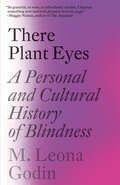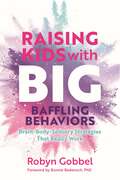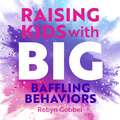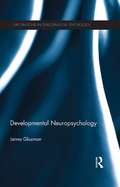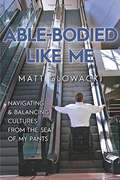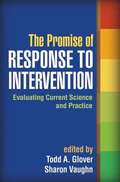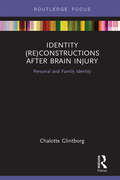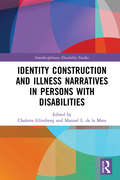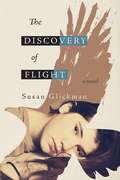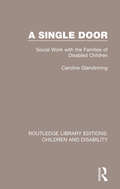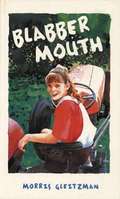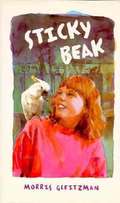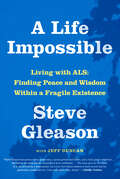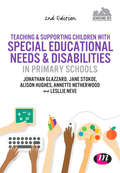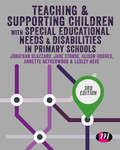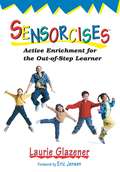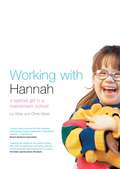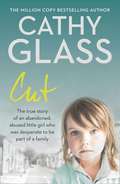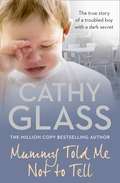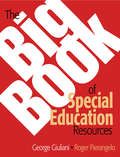- Table View
- List View
There Plant Eyes: A Personal and Cultural History of Blindness
by M. Leona GodinFrom Homer to Helen Keller, from Dune to Stevie Wonder, from the invention of braille to the science of echolocation, M. Leona Godin explores the fascinating history of blindness, interweaving it with her own story of gradually losing her sight. There Plant Eyes probes the ways in which blindness has shaped our ocularcentric culture, challenging deeply ingrained ideas about what it means to be &“blind.&” For millennia, blindness has been used to signify such things as thoughtlessness (&“blind faith&”), irrationality (&“blind rage&”), and unconsciousness (&“blind evolution&”). But at the same time, blind people have been othered as the recipients of special powers as compensation for lost sight (from the poetic gifts of John Milton to the heightened senses of the comic book hero Daredevil). Godin—who began losing her vision at age ten—illuminates the often-surprising history of both the condition of blindness and the myths and ideas that have grown up around it over the course of generations. She combines an analysis of blindness in art and culture (from King Lear to Star Wars) with a study of the science of blindness and key developments in accessibility (the white cane, embossed printing, digital technology) to paint a vivid personal and cultural history. A genre-defying work, There Plant Eyes reveals just how essential blindness and vision are to humanity&’s understanding of itself and the world.
Raising Kids with Big, Baffling Behaviors: Brain-Body-Sensory Strategies That Really Work
by Robyn Gobbel"All behavior makes sense"'"It most certainly does not!", is probably your first reaction.Parenting and neuroscience expert Robyn Gobbel is here to reveal how all behavior, no matter how baffling, can be explained and remedied. You just need to look past the behavior and understand what's going on inside.Robyn decodes the latest brain science into easy-to-understand principles and metaphors to help you become an expert in your child's behavior. She reveals simple ways to help you regulate and connect with your child, with brain-, body- and sensory-based strategies to overcome day-to-day challenges. She also provides you with the knowledge to understand and regulate your own brain so that you don't flip your lid when your child flips theirs.Let this be your lifeline for parenting or caring for any child with baffling behaviors and hidden challenges, including kids who have experienced adversity, or with additional needs.
Raising Kids with Big, Baffling Behaviors: Brain-Body-Sensory Strategies That Really Work
by Robyn Gobbel"All behavior makes sense"'"It most certainly does not!", is probably your first reaction.Parenting and neuroscience expert Robyn Gobbel is here to reveal how all behavior, no matter how baffling, can be explained and remedied. You just need to look past the behavior and understand what's going on inside.Robyn decodes the latest brain science into easy-to-understand principles and metaphors to help you become an expert in your child's behavior. She reveals simple ways to help you regulate and connect with your child, with brain-, body- and sensory-based strategies to overcome day-to-day challenges. She also provides you with the knowledge to understand and regulate your own brain so that you don't flip your lid when your child flips theirs.Let this be your lifeline for parenting or caring for any child with baffling behaviors and hidden challenges, including kids who have experienced adversity, or with additional needs.
Pip and Bunny: Pip at Home (Supporting Language and Emotional Development in the Early Years through Reading)
by Maureen GlynnPip at Home is the sixth book in the invaluable ‘Pip and Bunny’ collection; a set of six picture books with an accompanying handbook and e-resources carefully written and illustrated to support the development of visual and literary skills. By inspiring conversation and imagination, the books promote emotional and social literacy in the young reader. Designed for use within the early years setting or at home, each story explores different areas of social and emotional development. The full set includes: six beautifully illustrated picture books with text and vocabulary for each a handbook designed to guide the adult in using the books effectively ‘Talking Points’ relating to the child’s own world ‘What’s the Word?’ picture pages to be photocopied, downloaded or printed for language development detailed suggestions as to how to link with other EYFS areas of learning. The set is designed to be used in both individual and group settings. It will be a valuable resource for teachers, SENCOs (pre-school and reception), Early Years Staff (nursery, preschool and reception), EOTAs, Educational Psychologists, Counsellors and Speech Therapists.
Developmental Neuropsychology (Explorations in Developmental Psychology)
by Janna GlozmanDevelopmental Neuropsychology draws upon the research of Alexander Luria and Lev Vygotsky to present a comprehensive study of developmental neuropsychology from a Russian, and Western perspective. Janna Glozman offers a fresh and accessible analysis of Luria and Vygotsky’s collaboration, which greatly influenced the field of neuropsychology as we know it today. The text provides an examination of theoretical and methodological foundations of developmental neuropsychology, which Glozman describes and systemizes, before providing methods of assessment and neuropsychological aspects of specific situations. In her work Glozman considers: abnormal social mechanisms methods of assessment and remediation historical developments specific disabilities including dyslexia, ADHD and autism Glozman’s comparative text makes Russian developmental psychology practically accessible to a western audience. It is valuable reading for researchers in developmental and clinical psychology, as well as professionals in special education, speech therapy and social work.
Able-bodied Like Me: Navigating And Balancing Cultures From The Seat Of My Pants
by Matt GlowackiIn his insightful new memoir, Able-Bodied like Me, Matt Glowacki, civility speaker and author, chronicles the changing attitudes in our society—and in himself—about what it means to be disabled. <P><P>In the 1970s, when Glowacki was born, disabilities were still considered something to hide. Despite being born without legs, Glowacki pushed back against this narrative. He didn’t consider himself disabled and thought the term imposed unneeded limitations. He also balked at the tone-deaf remarks of others. He didn’t want to be an “inspiration” to people without impairments or a convenient way for others to signal their own virtue. Glowacki wanted to simply live his life, and he clearly explains how harmful certain remarks and actions can be for people in the disabled community. <P><P>In his memoir, Glowacki lists eighteen points to ponder as you reflect on your own assumptions and actions. Glowacki also examines his own changing beliefs about the term “disability,” as well as society’s shifting perspective. <P><P>As Glowacki shares the challenges he and others face in their everyday lives, he also offers suggestions about how to foster an environment of mutual respect and understanding. Glowacki certainly doesn’t want your pity. He just wants you to listen.
Promise of Response to Intervention
by Todd Glover Sharon VaughnAs response to intervention (RTI) is adopted by increasing numbers of schools and districts, knowledge about "what works" continues to grow. This much-needed book analyzes the key components of RTI service delivery and identifies the characteristics of successful implementation. Critically reviewing the available research, leading authorities describe best practices in multi-tier intervention, assessment, and data-based decision making. Clear-cut recommendations are provided for implementing evidence-based interventions to support students' needs in reading, writing, math, and behavior. A state-of-the-art resource for K 12 practitioners and administrators, the book also will fill a unique niche in graduate-level courses.
Identity: Personal and Family Identity (Interdisciplinary Disability Studies)
by Chalotte GlintborgIdentity (Re)constructions After Brain Injury: Personal and Family Identity investigates how being diagnosed with acquired brain injury (ABI) impacts identity (re)construction in both adults with ABI and their close relatives. To show how being diagnosed with ABI impacts identity (re)construction, this book investigates key patterns of identity construction. Discourse analysis, especially on the concept of positioning, provides an understanding of the changes and developmental processes in these self-narratives. These narrative (re)constructions point to a developmental change of identity in the course of the different phases of the recovery process for both persons with ABI and their relatives, including conflicting voices from society, service providers, relatives, and other adults with ABI. In addition, the (re)construction process is characterized by much ambivalence in both ABI survivors and relatives. Three perspectives are triangulated: (1) an insider perspective from ABI survivors; (2) an insider perspective from relatives; and (3) an outsider perspective from the researchers. This allows us to see how identities are negotiated and constructed in concrete situations. This innovative book will be required reading for all students and academics working in the fields of disability studies, rehabilitation psychology, sociology, allied health, and social care.
Identity Construction and Illness Narratives in Persons with Disabilities (Interdisciplinary Disability Studies)
by Chalotte GlintborgThis book investigates how being diagnosed with various disabilities impacts on identity. Once diagnosed with a disability, there is a risk that this label can become the primary status both for the person diagnosed as well as for their family. This reification of the diagnosis can be oppressive because it subjugates humanity in such a way that everything a person does can be interpreted as linked to their disability. Drawing on narrative approaches to identity in psychology and social sciences, the bio-psycho-social model and a holistic approach to disabilities, the chapters in this book understand disability as constructed in discourse, as negotiated among speaking subjects in social contexts, and as emergent. By doing so, they amplify voices that may have otherwise remained silent and use storytelling as a way of communicating the participants' realities to provide a more in-depth understanding of their point of view. This book will be of interest to all scholars and students of disability studies, sociology, medical humanities, disability research methods, narrative theory, and rehabilitation studies.
The Discovery of Flight (13c. Teen Gold( Cats Parade) #851)
by Susan GlickmanTwo threads comprise this young-adult novel, originally published in Canada. One is a journal that spans one school year in the life of twelve-year-old Sophie, and the other is the novel her sister, Libby is writing for her as a birthday surprise. Libby, who has cerebral palsy, communicates through the use of a computer. Sophie writes about school, friendship, preparing for her Bat Mitzvah, and her sister's deteriorating health. Libby's novel is a fantasy about the relationship between a girl and a hawk.
A Single Door: Social Work with the Families of Disabled Children (Routledge Library Editions: Children and Disability #Vol. 8)
by Caroline GlendinningFirst published in 1986, this study explores the increased public concern with policies of ‘community care’ and their effects on informal carers, at that time. It looks at the widespread evidence that one particular group of informal carers- parents looking after their severely disabled child- lack information, advice and a co-ordinated pattern of supporting services. The author, who carried out research on disabled children and their families for a number of years, describes in detail a low-cost experimental project in which specialist social workers set out to remedy these shortcomings. Drawing on the results of this particular study, the author argues strongly for widespread assignment of ‘key’ social workers to this and other groups of informal carers. Despite being written in the mid-1980s, this book discusses topic that will still be of interest and use today.
Blabber Mouth
by Morris GleitzmanSet in Australia, this humorous and touching story of the misadventures of a clever girl who cannot speak and her social misfit of a father will delight readers.
Sticky Beak
by Morris GleitzmanWhen Rowena, who is mute, rescues a pet cockatoo from the class bully, she begins to make sense of her feelings about the new baby her father and stepmother are expecting.
A Life Impossible: Living with ALS: Finding Peace and Wisdom Within a Fragile Existence
by Steve Gleason Jeff DuncanFrom NFL player Steve Gleason, a powerful, inspiring memoir of love, heartbreak, resilience, family, and remarkable triumph in the face of ALSIn 2011, three years after leaving the NFL, Steve Gleason was diagnosed with ALS, a terminal disease that takes away the ability to move, talk, and breathe. Doctors gave him three years to live. He was thirty-three years old. As Steve says, he is now ten years past his expiration date.His memoir is the chronicle of a remarkable life, one filled with optimism and joy, despite the trauma and pain and despair he has experienced. Writing using eye-tracking technology, Gleason covers his pre-ALS life through the highs and lows of his NFL career with the New Orleans Saints, where he made one of the most memorable plays in Saints history, leading to a victory in the first post-Katrina home game, uplifting the city, making him a hero, and reflected in a nine-foot bronze statue outside the Superdome. Then came his heartbreaking diagnosis. Gleason lost all muscle function, he now uses Stephen Hawking-like technology to communicate, and breathes with the help of a ventilator. This book captures Gleason and his wife Michel&’s unmatched resilience as they reinvent their lives, refuse to succumb to despair, and face his disease realistically and existentially.This unsparing portrait argues that a person's true strength does not reside solely in one&’s body but also in the ability to face unfathomable adversity and still be able to love and treasure life.
Teaching and Supporting Children with Special Educational Needs and Disabilities in Primary Schools (Achieving QTS Series)
by Jonathan Glazzard Jane Stokoe Alison Hughes Annette Netherwood Lesley NeveIf you are a primary trainee, or are training to support children in primary schools, this is your guide to working with children with Special Educational Needs and Disabilities (SEND). We begin by exploring what is meant by SEND in primary schools and go on to cover all you need to know about your statutory responsibilities in school. Current legislation and the Code of Conduct are covered, to give you lots of information about the content you will be working in. The book then examines the range of needs you will encounter in primary schools giving you details information and practical advice. This second edition has been fully restructured and updated to include a new section on the key theory relating to SEND. Exploring theories and theorist that you will need to know about to fully understand how to support children. Also new for this edition is a chapter focusing on the role of the SENCO in the primary school. Finally, the book includes more practical support to help you in the classroom. Checklists to help you to work comprehensively and information about useful resources and outside agencies.
Teaching and Supporting Children with Special Educational Needs and Disabilities in Primary Schools (Achieving QTS Series)
by Jonathan Glazzard Alison Hughes Annette Netherwood Lesley Neve Jane StokoeIf you are a primary trainee, or are training to support children in primary schools, this is your guide to working with children with Special Educational Needs and Disabilities (SEND). We begin by exploring what is meant by SEND in primary schools and go on to cover all you need to know about your statutory responsibilities in school. Current legislation and the Code of Conduct are covered, to give you lots of information about the content you will be working in. The book then examines the range of needs you will encounter in primary schools giving you details information and practical advice. This second edition has been fully restructured and updated to include a new section on the key theory relating to SEND. Exploring theories and theorist that you will need to know about to fully understand how to support children. Also new for this edition is a chapter focusing on the role of the SENCO in the primary school. Finally, the book includes more practical support to help you in the classroom. Checklists to help you to work comprehensively and information about useful resources and outside agencies.
Teaching and Supporting Children with Special Educational Needs and Disabilities in Primary Schools (Achieving QTS Series)
by Jonathan Glazzard Alison Hughes Annette Netherwood Lesley Neve Jane StokoeThis book begins by exploring what is meant by SEND in primary schools and goes on to cover everything trainees and teachers need to know about their statutory responsibilities in school. It then examines the range of needs they will encounter in primary schools with plenty of practical advice along the way. This third edition has been fully restructured and updated to include a new section on the key theories and theorists relating to SEND. Also new to this edition is a chapter focusing on the role of the SENCO in primary school. Finally, the book includes more practical support with coverage of current legislation and the Code of Conduct as well as checklists and information about useful resources and outside agencies.
Teaching and Supporting Children with Special Educational Needs and Disabilities in Primary Schools (Achieving QTS Series)
by Jonathan Glazzard Alison Hughes Annette Netherwood Lesley Neve Jane StokoeThis book begins by exploring what is meant by SEND in primary schools and goes on to cover everything trainees and teachers need to know about their statutory responsibilities in school. It then examines the range of needs they will encounter in primary schools with plenty of practical advice along the way. This third edition has been fully restructured and updated to include a new section on the key theories and theorists relating to SEND. Also new to this edition is a chapter focusing on the role of the SENCO in primary school. Finally, the book includes more practical support with coverage of current legislation and the Code of Conduct as well as checklists and information about useful resources and outside agencies.
Teaching Primary Special Educational Needs
by Jonathan Glazzard Alison Hughes Annette Netherwood Lesley Neve Jane StokoeToday, there is increased emphasis on the coverage of special educational needs in initial teacher training. This comprehensive introduction begins by looking at inclusion policy and how barriers to achievement can be removed. The SEN Code of Conduct is explained and detailed guidance on Individual Education Plans (IEPs) is included. The book then goes on to give practical advice on the teaching of children with special educational needs in reading, speech and language, the autistic spectrum and behavioural, social and emotional difficulties. Finally, the book considers the wider context looking at partnerships with parents, carers and professionals in other agencies.
Sensorcises: Active Enrichment for the Out-of-Step Learner
by Laurie GlazenerGet moving to prime the body for learning!All young students sometimes need a little extra help developing their senses. And many kids who are labeled as "problem students" simply lack the physical skills necessary to sit still, pay attention or even hold a pencil. Sensorcises helps students develop the very basic sensory skills needed for learning. Learn how to address the needs of these learners and help them develop the sensory motor skills they need to succeed.In this invigorating book, the author explores the REAL technique-Relax, Energize, Activate and Lead. By providing clear, step-by-step instructions, this book shows you how to design activity sequences to help students with sensory dysfunction as well as all the other learners in your K-5 classes. The author makes it incredibly easy to incorporate these exercises into any curriculum. Each research-based activity is fully described and illustrated with photographs to assist with classroom implementation.You AND your whole class will benefit from Sensorcises! They are the perfect way to boost energy levels while helping students focus their mind, body, and senses on achieving success.
Working With Hannah: A Special Girl in a Mainstream School
by Chris Glass Liz WiseWorking with Hannah is a unique and detailed snapshot of the first years of schooling for a child with Down's Syndrome and severe mobility and communication problems. Written by two classroom assistants, who supported Hannah during her two and a half years in a mainstream infant school, this book shows how the right level of support can make inclusion a success not only for the child and family but also for the school itself. This practical guide describes the 'hands on' approach of Hannah's day-to-day management in a busy school. Topics covered include:*finding a school*how the school prepares*adapting the curriculum*recognising the importance of friendship*incorporating therapies into the school day*additional aspects of personal and, physical care*setting up communication systems.There are key points at the end of chapters, which highlight the salient aspects and offer practical advice.
Cut: The True Story of an Abandoned, Abused Little Girl Who Was Desperate to Be Part of a Family
by Cathy GlassDawn was the first girl Cathy Glass ever fostered. A sweet and seemingly well balanced girl, Dawn's outward appearance masked a traumatic childhood so awful, that even she could not remember it. During the first night, Cathy awoke to see Dawn looming above Cathy's baby's cot, her eyes staring and blank. She sleepwalks--which Cathy learns is often a manifestation in disturbed children. It becomes a regular and frightening occurrence, and Cathy is horrified to find Dawn lighting a match whilst mumbling "It's not my fault" in her sleep one night. Cathy discovers Dawn is playing truant from school, and struggling to make friends. More worryingly she finds her room empty one night, and her pillow covered in blood. Dawn has been self-harming in order to release the pain of her past. When Dawn attempts suicide, Cathy realises that she needs more help than she can give. Dawn's mother eventually confides in her that Dawn was sent away to relatives in Ireland between the ages of 5 and 9, and came back very disturbed. She also sheds light on the reason for Dawn's fascination with matches and Cathy's baby. *SPOILER ALERT*SPOILER INFO FOLLOWS* Eventually Dawn is placed in a psychiatric home for children, and five years later she gets in touch with Cathy. She has been reconciled with her mother and is now training to become a teacher.
Mummy Told Me Not to Tell: The True Story of a Troubled Boy with a Dark Secret
by Cathy GlassReece is the last of six siblings to be fostered. Having been in care for four months his aggressive and disruptive behaviour has seen him passed from carer to carer. Although only 7, he has been excluded from school, and bites people so often that his mother calls him 'Sharky'. Cathy wants to find the answers for Reece's distressing behaviour, but he has been sworn to secrecy by his mother, and will not tell them anything. As the social worker prepares for the final hearing, he finds five different files on Reece's family, and is incredulous that he had not been removed from them as a baby. When the darkest of family secrets is revealed to Cathy, Reece's behaviour suddenly starts to make sense, and together they can begin to rebuild his life.
The Big Book of Special Education Resources
by George A. Giuliani Roger PierangeloSave time and frustration with this definitive special education resource to locate specialized clearinghouses and disability organizations, toll-free numbers, publications, state-specific entities, and more.
The Comprehensive Guide to Special Education Law: Over 400 Frequently Asked Questions and Answers Every Educator Needs to Know about the Legal Rights of Exceptional Children and their Parents
by George A. GiulianiIt is vital for all professionals in the field of education to have a practical understanding of the laws that are in place to protect the children with whom they work. The Comprehensive Guide to Special Education Law is a detailed yet accessible introduction to federal law as it applies to the rights of children with special needs. Written in a user-friendly question and answer format, the book covers all of the key areas of special education law including parental rights of participation, the legal right to Free Appropriate Public Education (FAPE) and related services, and the complex issues of discipline and dispute resolutions. This book provides educators with knowledge of the requirements, history, and evolution of the laws that impact their daily working lives and gives them the information they need to help parents obtain better services for their children. This is an indispensible handbook that teachers, school management, and school counselors will refer to again and again.
